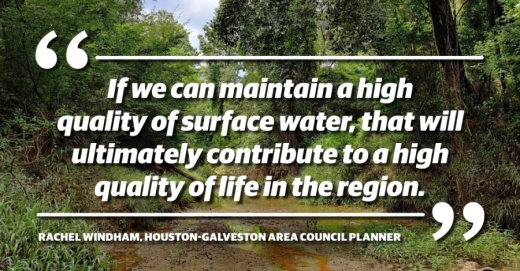The Spring Creek Watershed Partnership, a collaboration between community stakeholders, the Houston-Galveston Area Council and the Texas Commission on Environmental Quality, was established to analyze water quality concerns throughout Spring Creek's 440-square-mile watershed that spans Harris, Montgomery, Grimes and Waller counties. The partnership's first public meeting, initially scheduled for the spring, was delayed to to COVID-19 and held via videoconference July 29.
Watershed review
H-GAC planner Rachel Windham said water quality issues, including higher levels of certain nutrients and bacteria, factor into many aspects of daily life throughout the watershed and its many tributaries.
"Of course surface water is used by the natural environment, but it’s also important for recreational use, for industry and municipal use; it’s also used by agriculture," she said during the July meeting. "What this really boils down to is maintaining a high quality of life. So if we can maintain a high quality of surface water, that will ultimately contribute to a high quality of life in the region.”
Spring Creek flows west to east, where it meets with the West Fork San Jacinto River and Lake Houston—which Windham said is a key source of drinking water in the Greater Houston area. The H-GAC recently facilitated other regional plans centered on the Lake Creek, the West Fork San Jacinto River and Cypess Creek watersheds in addition to its Spring Creek project to highlight the preservation of Lake Houston's source waters into the future, Windham said.
H-GAC planner Justin Bower also noted while the Spring Creek partnership's primary goals will center on water quality, some of the organization's efforts may also complement work addressing flooding across the same area.
“One of the reasons I think the Spring Creek watershed is incredibly important is because it’s part of the broader Lake Houston and San Jacinto River system, which has seen some significant flooding and hydrologic impact," Bower said. "A lot of the things we’re going to be talking about in terms of water quality and impacts of growth and potential strategies are also things that will coordinate well with flooding.”
Quality concerns
One of the first tasks the Spring Creek partnership took on was analyzing the quality of water throughout Spring Creek and its tributaries, including Mill, Walnut and Brushy creeks to the west and The Woodlands-area waterways such as Bear and Panther branches and Lake Woodlands.
Results from 20 active monitoring stations collected between 2009-19 along Spring Creek and select tributaries showed levels of E. coli bacteria and phosphorus above state quality standards throughout several waterways and high nitrate levels in Willow Creek and Lower Panther Branch. One metric, dissolved oxygen levels, was shown to have generally improved in much of the watershed over recent years.
Windham said the prevalence of E. coli throughout the watershed may be caused by a variety of sources. The partnership's aim to identify and address those areas of contamination will be a priority as work continues to improve quality to acceptable levels for human use.
"Especially in cases where human waste pressures are indicated, there is an increased likelihood that additional pathogens could be present in waterways. Without taking action to manage sources of contamination, recreation activities such as swimming and wading in streams will not be safe for communities of the watershed," Windham said in an email. "More importantly, these negative effects could extend to the reservoir that Spring Creek and its tributaries drain into, Lake Houston."
The partnership's July session concluded with an overview of potential pollution sources and participant feedback. Its next meeting, expected to be held in the fall, will focus on both the continued analyses of watershed data and the selection of a steering committee to guide the development of a final watershed protection plan, Windham said.
"These discussions will provide the foundation for the next step in the planning process: determining solutions for improving water quality," Windham said.
A final version of the watershed protection plan, and its implementation, is expected by late 2021. More information on the watershed partnership and staff contacts may be found on the organization's website.





